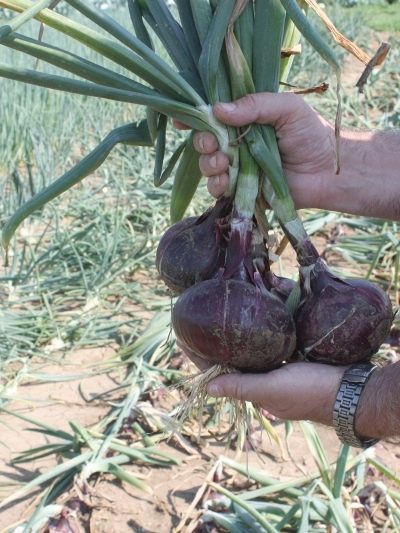
- Authors: Alekseev Yu.B.
- Year of approval: 2014
- Ripening terms: mid-season
- Bulb weight, g: 60-100
- The form: rounded
- Dry scales: purplish red
- Coloring juicy scales: reddish
- Taste: semi-sharp
- Appointment: universal
- Average yield: 218-337 c / ha
Onion Red Semko is a popular hybrid variety that can be classified as large-fruited. Agrarians appreciate it because it is mid-season, the bulbs are highly marketable. At the same time, ripening is amicable.
Breeding history
The author of this beautiful onion hybrid was the domestic breeder Alekseev Yuri Borisovich. The development was carried out on the basis of Semko-Junior LLC. In 2011, the work was completed, at the same time the company applied for admission. After successfully conducted variety trials in 2014, the crop was entered into the State Register and recommended for cultivation in the Central Region of the Russian Federation.
Description of the variety
The hybrid variety Red Semko is recommended as an annual crop for the cultivation of turnip onions from seeds. It is an early hybrid of red onion.
The variety has quite a few advantages:
- high productivity;
- excellent marketability;
- long keeping quality (5-6 months);
- excellent taste;
- resistance to stress in relation to adverse factors;
- cold resistance;
- good transportability;
- an increased amount of antioxidants in the composition.
In addition to the fact that this is a hybrid, and seeds must be bought annually, they note as a minus the need to grow crops in sunlit places.
Characteristics of the appearance of plants and bulbs
The leaves of the hybrid variety are of medium size, their color is dark green, there is not too intense wax bloom. Bulbs of the hybrid variety Red Semko are distinguished by their beautiful appearance, mainly due to the bright color of the outer scales. Dry scales, which are counted in 2-3 layers, can be red-lilac, purple-red or dark purple hue.
At the same time, the rounded bulbs are glossy, aligned, with a diameter of 6-10 centimeters. On average, each has a weight of 60-100 grams, but there are also heroes of 150-200 grams. On the cut, the inner juicy scales are lighter, sometimes white or reddish, with streaks of lilac or red-violet tones. The neck of the root crop is thin. Single- and double-edged bulbs.
Purpose and taste
The taste of Red Semko onion is semi-sharp. It is believed that red onions are very healthy. Nutritionists even recommend including it in the diet of people suffering from problems with blood vessels and capillaries. Due to the high content of antioxidants in the composition, red onion is a natural anticancer agent.
Maturation
Red Semko is a mid-season onion hybrid. From the appearance of the first shoots to the beginning of ripening of the bulbs, it takes from 90 to 95 days.
Yield
On average, the yield indicators of Red Semko onions are at the level of 218-337 c / ha. In 1 square meter, you can get 4-5 kilograms of useful products.
Growing regions
The hybrid is zoned for the Central region. This means that ideal conditions for obtaining high yields can be created in the fields and plots of the Bryansk, Vladimir, Ivanovo, Kaluga, Moscow, Tula, Ryazan and Smolensk regions.
Growing and caring
First of all, the considered hybrid variety differs in that it is grown as an annual. Options for planting seeds or seeding are possible. In the southern regions, Red Semko is grown by seeds. The beds and seeds are prepared in advance. As for the beds, a nutritious top dressing is applied to the soil: for 1 hundredth you will need 50-60 kilograms of compost, 600 grams of phosphorus-potassium fertilizers.For preliminary germination and seed treatment, special biological products are used, such as "Epin", "Gumi", "Kornevin". Onions Red Semko are planted according to the scheme of 30x5 centimeters.
The hybrid variety does not require very difficult care. Planting should be watered as needed - 1-2 times a week. After watering, the aisles are loosened, and weeds are removed in parallel. During the growing season, up to 3 root dressings are applied.

Since the onion is an unpretentious and cold-resistant plant, it can be planted both in spring and autumn. It is necessary to properly prepare the planting material, competently prepare the garden bed and determine the timing of planting.


The bow is not as unpretentious as it seems. For good growth, you need fertile soil, quality care and nutritious fertilizers. Without top dressing, the bulbs will grow small, and the greens will not be lush. At different stages, it should be fed with different substances. The vegetable needs organic and mineral feeding. A good result for fertilizing onions is the use of folk remedies.
Disease and pest resistance
Hybrid Red Semko has good immunity. However, from attacks of harmful insects such as onion fly, thrips, ticks use drugs "Decis", "Tsimbush", "Aktara", "Mukhoed".

Despite the fact that the onion is a very useful plant, capable of repelling and killing many microbes and bacteria, it itself is often damaged and suffers from various misfortunes. Diseases and pests of onions can significantly reduce the yield. It is necessary to correctly determine the presence of this or that disease and take appropriate measures in time.


















































































